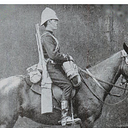Namibia: A timeline of Germany’s brutal colonial history which includes genocide
We sometimes forget that the United Kingdom was not the only Empire to wield power in Africa, unfortunately for African countries, there were Italians, Dutch, French, Belgium, and Portuguese all trying to make the Continent their own. All committed crimes against the African people non more so than both Germany and Belgium.
Today let's look at the timetable of Germany in Africa and what it did in its brutal colonial history in Africa
Though relatively short-lived, Germany’s colonial presence has had a major impact on present-day Namibia. Here’s a timeline of Germany’s brutal colonial past in the African country.
It begins in the 1840s, Missionaries from the German-based Rhenish Missionary Society arrived in what is now called Namibia.
1883: Adolf Lüderitz, one of Germany’s first prominent colonialists, signs an agreement with Chief Joseph Frederick of Bethanie in what is now southern Namibia. The treaty gives the German businessman rights to the area around a strategic natural harbour called Angra Pequena, which he renames Lüderitz.
1884/85: Following the Berlin Conference, the territory of present-day Namibia becomes a protectorate of the German Empire called German South West Africa. No local people are part of these decisions made by European powers.
1890: The Anglo-German Heligoland-Zanzibar Treaty comes into force. Germany acquires access to the Zambezi River from South West Africa by creating a 30-kilometer-wide (18-mile-wide) ribbon of land known as the Caprivi Strip, named after German Chancellor Leo von Caprivi.
1893: Skirmishes between German soldiers sent to protect German settlers and local Herero, Nama and Witbooi clans increase. German Governor Curt von Francois’s men attack Nama Chief Hendrik Witbooi and the village of Hornkranz, massacring women, children and the elderly. Witbooi retaliates and temporarily disrupts transport from coastal Swakopmund to central Windhoek.
1894: Theodor Leutwein replaces von Francois as governor of South West Africa. He negotiates protection treaties with communities but attacks and subdues those who refuse to surrender to German protection.
Leutwein mounts a large-scale attack on Hendrik Witbooi in the Naukluft Mountains. When the Germans defeat Witbooi, he signs a protection treaty.
1895: The German Schutztruppe is established. This fighting force is to defend German interests in South West Africa and suppress any dissent against the colonial administration. Often employing scorched-earth tactics and making little distinction between combatants and non-combatants, the Schutztruppe at times includes over 15,000 German soldiers.
August 1904: The Battle of Waterberg hands German forces under General Lieutenant Lothar von Trotha a decisive victory over Chief Samuel Maharero and Herero rebels. Von Trotha then gives an extermination order, warning that every Herero found in German-occupied land will be executed. Unarmed Hereros are routinely shot or hanged, their cattle are either stolen or killed and German settlers take over the land. This is in response to the killing of around 120 German settlers and soldiers by local tribespeople. Massacres of Herero and Nama people by German colonists and the Schutztruppe follow the Battle of Waterberg and Trotha’s order. Hereros are driven into the harsh Omaheke region, where thousands die of hunger and thirst.
1904–1908: Clashes between German forces and Herero and Nama rebels continue, but Herero resistance is largely broken, with Schutztruppe soldiers rounding up survivors. The remaining refugees, including women and children, are forced into concentration and labour camps to work for German businesses and infrastructure projects to build up the German colony. Herero land is seized and distributed among German settlers.
German scientists take some skulls of the victims to Germany to study and develop the now-discredited theory of eugenics, which sought to establish scientific reasons for the superiority of Europeans over other races.
While figures remain disputed, conservative estimates say about 65,000 of 80,000 Herero (up to 75% of the then population), and at least 10,000 out of 20,000 Namas were killed under German rule. Up to 100,000 people are said to have died at the hands of German forces. This period of history is now widely accepted as the 20th century’s first genocide.
When have we seen pictures like these before?
1907: Berlin recalls von Trotha, whose brutal methods of establishing German control over South West Africa have been condemned in Africa and Europe.
July 1915: Germany loses control of South West Africa to Allied and South African troops.
1919: After Germany’s defeat in the First World War, the Treaty of Versailles forces it to give up its colonies.
1923: Chief Samuel Maharero dies in exile in present-day Botswana.
March 1998: German Federal President Roman Herzog visits Namibia. Hereros demand reparations for German atrocities during the period from 1904–1908.
August 14, 2004: The German minister for development, Heidemarie Wieczorek-Zeul, recognizes Germany’s historical and moral responsibility for the genocide of the Herero and Nama people after 100 years. Germany’s responsibility is to be enacted through development aid.
September 30, 2011: Germany returns skulls from colonial-era killings to Namibia for the first time. More skulls and bones are returned during separate ceremonies in 2014 and 2018.
March 29, 2014: Representatives of Nama and Herero again demand reparations from Germany for genocide during the colonial war 1904–1908.
2015: Negotiations start between the Namibian and German governments over an official apology and aid money.
July 7, 2016: For the first time, the German government recognizes the mass murder of Herero and Nama by German troops as genocide in an official document.
May 28, 2021: After six years of negotiations, German Foreign Minister Heiko Maas announces an agreement has been reached in which Germany recognizes the atrocities committed against the Herero and Nama people in the early 1900s as genocide. Berlin pledges to spend €1.1 billion ($1.3 billion) over 30 years for infrastructure and development aid in Namibia. The payments do not include reparations and are derided by Herero and Nama leaders as “unacceptable.”
